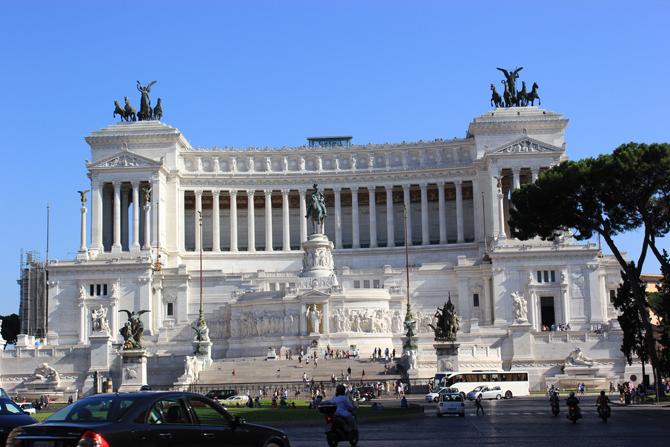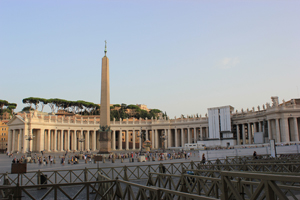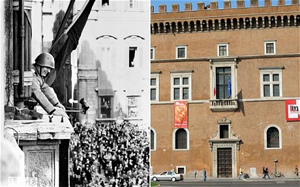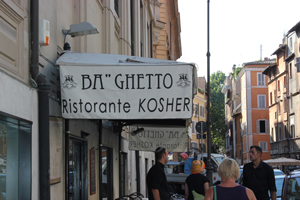Written by: Dr. Dushka H. Saiyid - Posted on: December 31, 2012 |  Comments | 中国 (Chinese)
Comments | 中国 (Chinese)
Google Translation: اُردو | 中文
Rome is a city of piazzas, fountains, Baroque and Renaissance art and architecture, and a shopper’s paradise for those interested in quality. Noisy restaurants and pizzerias spill onto the cobbled roads and piazzas, giving the city a lively atmosphere in the evenings.
The grandiose architectural and artistic projects commissioned by the Popes and the church, were the Catholic church’s response to the Reformation, and St Peter’s was the most forceful expression of it. It took almost the whole of the sixteenth century for Saint Peter’s to be built. Michaelangelo’s design of its dome, is considered his greatest architectural feat. The Vatican Museum houses masterpieces of art: Michaelangelo’s Sistine Chapel and the Rafael Rooms, which also houses Rafael’s famous painting, “School of Athens.”
 |
| Il Vittoriano |
The Council of Trent (a conference of ecclesiastical dignitaries and theological experts) of the Roman Catholic Church, that met in the middle of the sixteenth century in response to the Reformation, decided that arts should communicate religious themes in a direct and emotional way. The popes lavished money on these projects, and the baroque movement of the seventeenth century was born, full of movement, drama and emotion. Bernini was its most distinguished exponent, and his stamp seems to be everywhere, from the fountain in the famous Piazza Navona, where the four rivers are symbolized by four figures, to the piazza of St Peter’s and decorations of the Basilica of St Peter. Some of Bernini’s finest sculptures are housed in the Borghese palace: his David is both fluid with movement and intense as he twists to use his sling against Goliath, an expression of concentration and intensity on his face, a far cry from Michaelangelo’s rather still and almost narcissistic David.
 |
| Piazza San Pietro |
But Rome is not all art and sculpture, for opera is as central to the Italian way of life as pasta is to their dining, and is captured by Woody Allen (an American film director) in his latest cinematic offering, “Love in Rome”. Opera is a powerful medium, but seeing “Attila” (the feared ruler of an empire between rivers Ural and Rhine who threatened Rome, but never took it), performed against the ruins of Baths of Caracalla, was an experience. Walking back to the hotel on our last night in Rome, we heard music and traced it to the Spanish Steps. What a sight! Thousands sat or stood in rapt attention and even joined the opera singers as they sang some of the more popular numbers. Young and old, feasted on this free opera arranged by a local authority; no jostling or pushing, as the cameras and video recorders clicked.
| Opera at the Piazza de Spagna |
 |
| Mussolini addressing the crowd from the balcony of Palazzo Venezia |
An interesting but controversial late 19th century monument is Il Vittoriano, which overlooks Piazza Venezia. It is an overpowering massive marble building on a hill, with a giant equestrian sculpture of Victor Emmanuel II, the first king of unified Italy, dominating the skyline. It is dedicated to the Risorgimento, or the struggle for the unification of Italy, which was completed in 1861. It also houses the Museo Central del Risorgimento, which has memorabilia of the struggle. Led by such romantic and heroic figures as Garibaldi and Mazzini, the reformist Young Turk party of the early 20th century, seems to have been inspired by Mazzini’s Young Italy movement of the 1830s.
Another building in this piazza with historical significance is the Palazzo Venezia. It was one of the first Renaissance buildings to be built in Rome between 1455 and 1464. The embassy of the Venetian Republic was housed here, however, Mussolini used it as his headquarter. He used to address and harangue the crowds in the piazza from the balcony.
The Jews have successfully maintained their identity over the centuries in Europe, while contributing to the society and economy of their adopted country in Europe. The Jewish community in Rome is the oldest in Europe. They first started coming as envoys in the 1st century BC, and when Romans invaded Judea in 63 B.C.E, they were made prisoners of war and brought to Rome as slaves. It was during the Reformation in 1555, that Pope Paul IV decreed that all Jews should be segregated in their own quarters or ghettos, and their rights were severely restricted.
 |
| Jewish Ghetto |
Click to view picture gallery